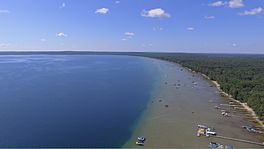Higgins Lake facts for kids
Quick facts for kids Higgins Lake |
|
|---|---|

Aerial view of the lake's north shore
|
|
| Location | Roscommon County, Michigan, United States |
| Coordinates | 44°28′56″N 84°42′31″W / 44.48230°N 84.70871°W |
| Type | Glacial Lake |
| Primary inflows | Springs, precipitation, streams, Big Creek |
| Primary outflows | Cut River to Marl Lake |
| Catchment area | 19,000 acres (7,700 ha) |
| Basin countries | United States |
| Max. length | 7 mi (11 km) |
| Max. width | 4 mi (6.4 km) |
| Surface area | 9,900 acres (4,000 ha) |
| Average depth | 44 ft (13 m) |
| Max. depth | 135 ft (41 m) |
| Residence time | 12.5 years |
| Shore length1 | 21 mi (33.7 km) |
| Surface elevation | 1,155 feet (352 m) |
| Islands | 1 |
| 1 Shore length is not a well-defined measure. | |
Higgins Lake is a large and beautiful lake in Roscommon County, Michigan, United States. It's a very popular place for fun activities like swimming, boating, and fishing. The lake is famous for its very deep and clear water.
Higgins Lake is the 10th largest lake in Michigan. It covers about 9,900 acres (40 square kilometers). The lake is named after Sylvester Higgins, who was the first chief of the Michigan Geological Survey's mapping department.
Contents
About Higgins Lake
Higgins Lake is shaped a bit like two connected circles. It is about 7 miles (11 km) long and 4 miles (6.4 km) wide. The deepest part of the lake is 135 feet (41 meters) deep, and its average depth is 44 feet (13 meters).
The lake gets half of its water from underground springs. Some water also comes from small streams, rainfall, and runoff from the land. Water flows out of Higgins Lake through the Cut River. This river then goes into Marl Lake and later into Houghton Lake, eventually reaching Lake Michigan.
Fish and Fishing
Higgins Lake is a great spot for fishing! You can find many kinds of fish here, including yellow perch, trout, smelt, and pike. People enjoy fishing in the open water during warmer months. When the lake freezes in winter, many people go ice fishing.
Higgins Lake is considered an "oligotrophic" lake. This means that even though it gets some nutrients, its large size makes it act like a lake with very few nutrients. This helps keep the water clear.
Nearby Communities and Parks
The small community of Higgins Lake is located along the western side of the lake. The lake itself is on the border between Lyon Township and Gerrish Township.
There are two state parks right on the lake:
- South Higgins Lake State Park: This park has a mile of shoreline. It's older, larger, and has more facilities.
- North Higgins Lake State Park: This park was once home to the world's largest tree seedling nursery. This nursery was part of the CCC program in the 1930s.
Both parks offer public boat launches and camping areas. They are very popular places to visit, especially during the summer.
History of the Lake's Name
Long before European settlers arrived in North America, the Chippewa people lived near the lake. They had their own name for it: Majinabeesh. This beautiful name means 'sparkling water', which perfectly describes Higgins Lake!
Protecting Our Lake
In recent years, more and more people have moved to live near Higgins Lake or visit it for recreation. This has made people concerned about the lake's water quality. Citizens and local governments are working together to keep the lake healthy.
Environmental Challenges
One concern is that the lake might be getting too many nutrients. These nutrients, like phosphorus and nitrogen, can come from septic systems, fertilizers used on lawns, and water running off roads. Too many nutrients can cause problems for the lake's ecosystem.
A big change for the lake has been the arrival of zebra mussels. These are tiny invaders that attach to surfaces. They don't have any natural predators in U.S. waters. Zebra mussels can harm native clams and cause more plants to grow on the bottom of the lake.
What People Are Doing
People who live around Higgins Lake are working hard to protect it. They are asking for new rules to make sure boats are cleaned before they enter the lake. This helps stop new unwanted plants or animals from getting into the water. They are also supporting programs to fight other foreign pests and protect the lake's natural environment for everyone to enjoy.
Gallery





